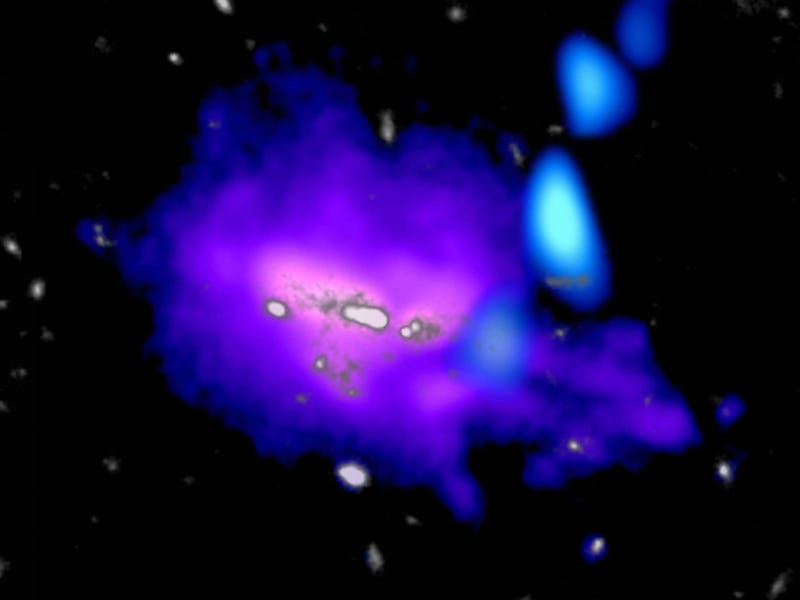Astronomers Just Found a Half-Million Light Year Long Stream in the Early Universe
The enormous structure is made of cold carbon.

Astronomers have been looking for the source of the matter that makes up early galaxies for decades. Now, for the first time, astronomers have observed the cold, steady streams of gas that make up the raw material for stars.
Despite the name, the filamentary stream surrounding and heading into the galaxy 4C 41.17— more than 10 billion light years away — is immense: a thin stream of cold carbon gas 100 kiloparsecs, or half a million light years, wide, and as massive as 140 billion suns. That’s the results found in paper published this week in Science, which resulted from an unusual use of a radio telescope.
While simulations have long predicted that cold streams like this one must exist, actually catching sight of one is much more difficult. While galaxies contain plenty of things that can give off enough energy to be detected from Earth, a gas stream like this one is not only diffuse and relatively narrow, but extremely cold. The supermassive black holes that back-light the gas stream can reach temperatures into the trillions of Kelvin. This gas stream, though, is cold — between just 10 and 100 degrees above absolute zero.
It’s this cold gas that forms the building blocks of early galaxies. Higher-temperature gasses, ionized by ambient ultraviolet photons, are simply too warm and too energetic to collapse into stars. Although early galaxies are surrounded by halos of hot, ionized hydrogen, streams like this one must be able to break through to feed the formation of stars.
“Now, we’ve seen observational evidence not just for a steam like that,” Bjorn Emonts, an astronomer at the National Radio Observatory and one of the authors of the piece, tells Inverse, “but the stream carrying already the raw building blocks for star formation, the very cold gas from which stars form.”
Part of the ALMA Observatory
Why did observing carbon gas take so long?
It isn’t just that this stream of carbon gas is so very cold that makes it difficult to see, though. Because the stream stretches across such a vast distance, Emonts explains, the team actually had to try to defocus the telescopes they were using to pick it out “as much as possible.” “If you zoom in too much, you miss out on all this gas,” he says.
But while it’s easy to imagine how you might do that with a backyard telescope or a pair of binoculars, it’s something else altogether with the kind of telescope you need to pick out a stream of cold gas from 10 billion light years’ distance. The team used the Atacama Large Millimeter Array, or ALMA, a set of sixty six radio telescope dishes scattered across the three-mile-high Atacama Desert in northern Chile.
The dishes work on the principle of interferometry, moving closer or further apart in order to pinpoint the source of distant emissions. In order to see the gas on such a huge scale, Emonts says, they had to “put all the antennas together as closely as possible, sacrificing resolution but gaining sensitivity for detecting very extended emissions.”
Even though this stream is half a million light years long, it’s not clear what its source is—either in terms of where it comes from or where the carbon it carries originated. Because carbon must have been created in stars, it can’t simply be a cloud of gas that has hung around outside of galaxies since the Big Bang. It must have come from some earlier galaxy—although whether or not that’s 4C 41.17 is unclear.
“We suspect the gas from the stream itself may come from a much larger scale structure like the cosmic web,” Emonts explains, “a filamentary structure of gas, galaxies, and dark matter that stretches the whole universe.” If it’s the case that the gas that fuels the galactic motor of star formation comes from the cosmic web, he says, “it would be an almost unlimited supply of gas that would be dumped on a galaxy like this.”
This cold stream of gas may have kickstarted galaxy formation.
What’s next
For the time being, the next steps involve returning to ALMA and New Mexico’s Very Large Array and take them out of focus again—in order to see if this stream is, in fact, one of many. Unlike ALMA, the VLA is especially well-tuned to see carbon monoxide, which appears at a different frequency. “Of course, we don’t believe all the cold gas is carbon atoms; more likely it’s hydrogen,” Emonts explains. “If you know there’s carbon, you know there’s a large reservoir of gas.”
“We want to look at other systems in the distant universe,” Emonts says, “and try to defocus as much as possible and see this very extended streamlike structure.” In the case that they do find them going forward, and it turns out that these cold, dark ribbons of gas are “a phenomenon that occurs around other distant galaxies, then it must be a general phenomenon — a main phenomenon of forming galaxies.”